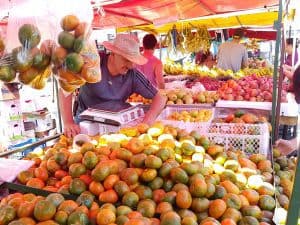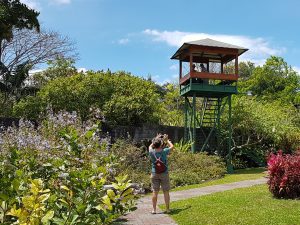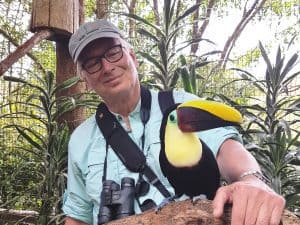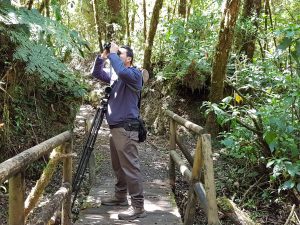From botanical gardens and wildlife centres to museums and coffee farms, the San José area has much to offer
As we boarded the bus to San Isidro de Heredia, we were sorry to leave Puerto Viejo, but felt satisfied that we’d experienced much of what Costa Rica’s Caribbean coast has to offer. Our friends, Mike and Sonja Barker had especially enjoyed the music scene and yoga; my wife, Michelle, was enamored by the restaurants and cafés; while all of us were enchanted by the prodigious wildlife However, we were also looking forward to our final 10 days of the trip in the much cooler San Isidro area, located in the Central Valley northeast of San José.
Although the region of San Isidro is much more developed and not as biologically rich as Puerto Viejo, it offers much of interest, including farmers markets, picturesque villages and great dining. Michelle was able to find us a very comfortable, modern house through VRBO. The American owner, Steve Huffstutlar, was everything you could expect in a host: tour guide, problem solver and authority on all things Costa Rican. I especially enjoyed chatting with him about Costa Rican Spanish, which has some unique features. For example, the familiar personal pronoun “tu” is not used at all, while the use of “usted” is ubiquitous, even between parents and their children. The signature Spanish expression of the country is “pura vida” which means “pure life”, but is commonly used as a salutation or exclamation.
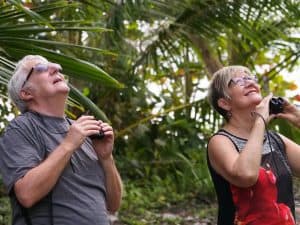
Mike Barker and my wife Michelle watching some of Costa Rica’s amazing birdlife (Photo by Drew Monkman)
I also enjoyed chatting with Steve’s bilingual on-site manager, Eduardo Chumpitasi, who is a very knowledgeable amateur lepidopterist. He showed me his huge collection of moths and butterflies, many of which he had collected in his own yard. His wife, Agnes, showed me the Monarch caterpillars she was raising with her grandchildren. Monarchs are a non-migratory, resident species here and surprisingly common.
Steve’s property had a good selection of flowering shrubs and trees – including many conifers – which attracted a wide diversity of birds. Blue-and-white Swallows coursed overhead, while Grayish Saltators sang from trees and Rufous-collared Sparrows fed on the lawn. Every night, a Common Pauraque – a bird closely related to the Whip-poor-will – serenaded us with its loud, whistled “kweeeuu” call. The laneway, which crossed a nearby creek, turned out to be a great place to see North American migrants like Baltimore Orioles, Summer Tanagers, Wilson’s Warblers and Louisiana Waterthrush. In all, I was able to find 37 species within five minutes of the house.
Steve provided us with a long, detailed list of places to visit within an hour or two of San Isidro. This included a number of museums in San José. We especially enjoyed the National Museum of Costa Rica with its butterfly conservatory and amazing exhibit of pre-Colombian artifacts. The only downside of going into the capital was the horrendous traffic.
Bougainvillea Hotel
The number one destination on Steve’s list was the Bougainvillea Hotel. The grounds are essentially a two-acre botanical garden. The plants are all identified, so a visit here provides a great introduction to Costa Rican flora. There are even ponds created specifically for endangered frogs. The grounds also attract a wide variety of bird life, including motmots, tanagers and many migrants like Tennessee Warblers. My favourite viewing spot was an observation tower, which afforded great photography opportunities. At only a half-hour from the airport, I would recommend the hotel to anyone travelling to Costa Rica and wanting to spend a restful night or two upon arriving or departing. The hotel is very environmentally conscious and the dining is superb.
La Paz Waterfall Gardens
One of our most memorable days was a visit to La Paz Waterfall Gardens, situated northwest of San Isidro on the way to the Poas Volcano. We loved the scenic drive as we passed by coffee farms and grazing dairy cattle. The views of the valley below were spectacular. La Paz Waterfall Gardens is the most popular privately-owned ecological attraction in Costa Rica and offers a marvelous introduction to Costa Rica’s iconic wildlife. It has the most esthetically-pleasing wildlife enclosures and beautiful waterfalls I’ve ever seen. La Paz has been developed in such a way as to combine environmentally conscious design with maximum educational impact.
Among the highlights are a huge, jungle-like aviary with numerous species of native birds, a butterfly observatory and exhibits of live frogs and snakes. You can also see some of the country’s iconic mammals like Howler and Spider Monkeys, Three-toed Sloths, Ocelots and even a Jaguar. Seeing these animals up close gives a real sense of how precious – and fragile – Costa Rica’s wildlife actually is. If you’re interested in plants, the orchid and Heliconia gardens are a must-see, as well. The high point of the day for Michelle and me, however, was the hummingbird garden, where feeders attract wild birds living in the area. No fewer than 26 different species have been documented here. The birds are so close that you can feel the air displaced by their wings as they zip by your head and feed only metres away. Just make sure your camera has a memory card with lots of space!
Finca Cristina and Ark Herb Farm
On another occasion, we drove southeast of San Jose to Finca Cristina, an organic shade-grown coffee farm. It is located near Cartago, which has the country’s grandest colonial-era church, the Basilica de Nuestra Senora de Los Angeles. Finca Cristina is dedicated to producing Arabica coffee while at the same time protecting and preserving native flora and fauna. The farm is located in the middle of a major flyway for neo-tropical migratory birds and provides important habitat for threatened North American species like Cerulean and Canada Warblers. While we were tasting some of the outstanding coffee the farm produces, we watched the fruit and nectar feeders and the constant coming and going of both resident and migratory species.
We toured the farm with one of the owners and learned about the labour-intensive process of producing shade-grown organic coffee. I have a new appreciation for why it’s more expensive! Managing the shade trees, most of which are banana plants, is nearly as involved as tending to the coffee trees themselves. Pest management, too, is also a huge part of the operation.
Another memorable tour was at the Ark Herb Farm, which has one of the largest collections of herbs and other medicinal plants in Central America. It is a focal point for herbalists, botanists and plant lovers. The plants are all identified and marked with symbols signifying how they can be used. Our guide was a wonderfully informative ethnobotanist who regaled us with all kinds of anecdotes and stories. He was especially passionate about the dream-inducing qualities of Brugmansia and how the leaves can be used to treat skin problems. We also tasted incredibly sweet Stevia leaves and learned about the relationship between passionflower vines and Heliconius butterflies. The study of these butterflies has helped scientists to understand how new species are formed and why nature is so diverse.
Barva Volcano
My birding highlight of this second leg of our Costa Rican trip was a visit to Barva Volcano, north of San José. At nearly 10,000 feet above sea level, it is home to beautiful cloud forest habitat with trees draped in lichens and moss.
When I arrived at 6 am with my guide, Michael Jimenez Quesada, we were greeted by the ethereal song of the Black-faced Solitaire and the far-carrying calls of Prong-billed Barbets. It wasn’t until the sun climbed higher in the sky, however, that bird activity really increased. Much of it came courtesy of hummingbirds. Tiny Volcano and Scintillant Hummingbirds dashed around like over-sized bumble bees, while male Green Violet-ears chipped their incessant two-note song. A beautiful female Purple-throated Mountain-gem posed obligingly for us for several minutes, its orange breast and throat standing out clearly against the green leaves.
As we walked along the road towards the park entrance, we quickly added other high-altitude species like Mountain Elaenia, Long-tailed Silky Flycatcher and Golden-browed Chlorophonias. The latter were carrying lichens to line their nest in a bromeliad, nestled on a tree branch. A rare but obliging Black-billed Nightingale Thrush hopped out onto the road and allowed close-up views.
Upon entering the park, we took a trail that eventually led to the Barva Lagoon, the largest caldera on the volcano. The climb was quite a workout in the thin air, and I swore to myself that if I ever return, I’ll do so 20 pounds lighter! When I stopped to catch my breath, I tried out some pishing. Almost immediately, a beautiful male Golden-winged Warbler popped out of the vegetation and lingered on a branch only metres away. It was soon joined by a pair of Collared Redstarts that posed for us for nearly five minutes. It was then that Michael heard the plaintive call notes of a pair of Resplendent Quetzals. Only seconds later, the male flew in and perched briefly above the trail, its emerald green chest and crimson-red belly glowing in the sunlight. When it flew off, the tail coverts streaming behind the bird were as long as its body. Michael was as excited as I was and remarked, “I often have birders that cry when they see their first quetzal!”
Arriving at the observation platform over the lagoon, we had amazing views in all directions. On a clear day, it’s possible to see both the Atlantic and Pacific Oceans. The birding had not been easy, but adding nearly 10 life birds to my list made it all worthwhile.
Our six weeks in Costa Rica was everything we hoped it would be. We are destined to return!
